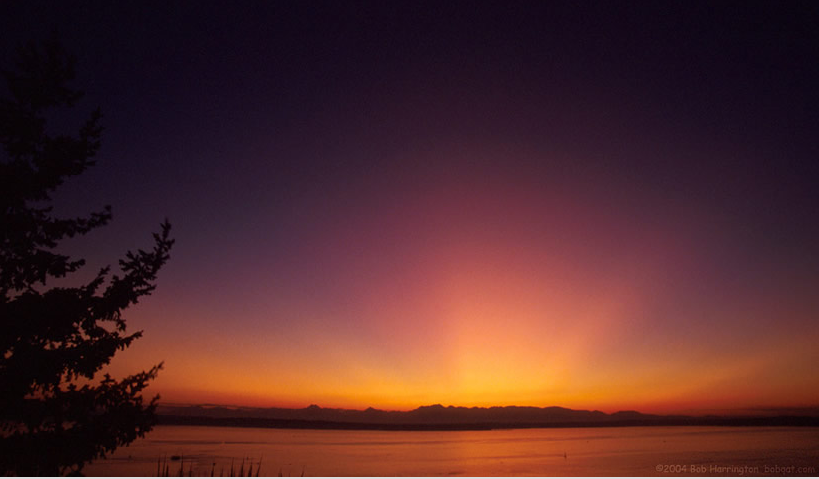Vocanic ash and sunsets
Volcanic Ash and Sunsets: A Spectacular Display of Nature's Beauty
When a volcano erupts, it releases a tremendous amount of dust and gaseous sulfur dioxide into the stratosphere. This eruption can inject millions of tonnes of particles into the atmosphere, where they can remain aloft for years and spread across the globe. As these particles disperse, they create a stunning array of optical phenomena that enhance the beauty of sunsets and twilight skies.
One of the most striking effects of volcanic ash in the atmosphere is the intense yellow-red horizon and purple-pink glows that grace the sunset and twilight hours. These vibrant hues are a result of the dust particles and aerosols scattering and refracting sunlight in unique ways. The purple glow, for example, is believed to be a combination of red-orange light transmitted through the lower atmosphere and scattered blue light from still sunlit stratospheric dust.
But the visual spectacle doesn't end there. Volcanic ash also has another fascinating optical effect known as a Bishop's ring. This phenomenon occurs when the small particles diffract light, forming a large variant of a corona. A corona is a ring of light that surrounds the Sun or Moon, caused by the diffraction, or bending, of light around tiny water droplets or ice crystals in the atmosphere. In the case of volcanic ash, these tiny particles create an even more impressive display, known as a Bishop's ring.
The Bishop's ring is a remarkable sight to behold. It appears as a circular band of light encircling the Sun or Moon, much like a halo. The ring is larger and more pronounced than a typical corona, thanks to the larger size and greater number of particles in the volcanic ash. This phenomenon adds an extra layer of awe-inspiring beauty to the already mesmerizing sunset or twilight sky.
The presence of volcanic ash in the atmosphere can have long-lasting effects on the Earth's climate. The fine dust particles can remain aloft for extended periods, spreading across vast distances and affecting sunlight penetration. This can lead to a cooling effect on the planet's surface, as the ash acts as a barrier, blocking a portion of the sun's rays. Scientists study these effects to better understand the impact of volcanic eruptions on global climate patterns.
In addition to their visual splendor, volcanic ash and sulfur dioxide also play a role in the formation of aerosols. Sulfur dioxide released during volcanic eruptions reacts with other compounds in the atmosphere to create sulfuric acid aerosols. These aerosols contribute to the overall particulate matter in the atmosphere, which can have implications for air quality and human health.
The study of atmospheric optics provides valuable insights into the complex interactions between light and atmospheric particles. Volcanic ash and its effects on sunsets and twilight skies offer a fascinating avenue of exploration within this field. By understanding these phenomena, scientists can deepen their understanding of the Earth's atmosphere and its intricate processes.
In conclusion, volcanic ash injects vast amounts of dust and gaseous sulfur dioxide into the stratosphere during volcanic eruptions. The resulting dispersion of particles creates stunning sunset and twilight effects, including intense yellow-red horizons and purple-pink glows. Additionally, volcanic ash gives rise to the awe-inspiring Bishop's ring, a variant of a corona formed by the diffraction of light by small ash particles. These optical phenomena not only captivate our senses but also provide valuable insights into the Earth's climate and atmospheric processes. Mother Nature's artistry truly knows no bounds.

Sunset/twilight sky over Puget Sound, Washington State showing the effects of stratospheric ash from the eruption of Mount Pinatubo. Imaged by Seattle photographer Bob Harrington (site) Bishop's ring. Image©2001 Bob Harrington, reproduced with permission.
Volcanic eruptions can inject millions of tonnes of dust and gaseous sulfur dioxide into the stratosphere. The finer dust particles remain aloft for years and spread around the world while the sulphur dioxide evolves to an aerosol of sulfur acids that add to the particulates.
The dust and aerosol produce vivid sunset and twilight effects like the intense yellow-red horizon and purple-pink glows of the photograph. The purple glow is probably a combination of red-orange light transmitted through the lower atmosphere and scattered blue light from still sunlit stratospheric dust.
The volcanic ash has another optical effect. The small particles can diffract light to form a huge variant of a corona called a Bishop's ring.
Note: this article has been automatically converted from the old site and may not appear as intended. You can find the original article here.
Reference Atmospheric Optics
If you use any of the definitions, information, or data presented on Atmospheric Optics, please copy the link or reference below to properly credit us as the reference source. Thank you!
-
<a href="https://atoptics.co.uk/blog/vocanic-ash-and-sunsets/">Vocanic ash and sunsets</a>
-
"Vocanic ash and sunsets". Atmospheric Optics. Accessed on April 27, 2024. https://atoptics.co.uk/blog/vocanic-ash-and-sunsets/.
-
"Vocanic ash and sunsets". Atmospheric Optics, https://atoptics.co.uk/blog/vocanic-ash-and-sunsets/. Accessed 27 April, 2024
-
Vocanic ash and sunsets. Atmospheric Optics. Retrieved from https://atoptics.co.uk/blog/vocanic-ash-and-sunsets/.